
Coccoloba uvifera is a species of flowering plant in the buckwheat family, Polygonaceae, that is native to coastal beaches throughout tropical America and the Caribbean, including southern Florida, the Bahamas, the Greater and Lesser Antilles, and Bermuda. Common names include seagrape and baygrape.

Ametris is a genus of moths in the family Geometridae.

Catocala ilia, the Ilia underwing, beloved underwing or wife underwing, is a moth of the family Erebidae. The species was first described by Pieter Cramer in 1776. It can be found in the eastern part of the United States as well as southern Canada. Subspecies Catocala ilia zoe can be found in California and Arizona.

Hulodes caranea is a species of moth of the family Erebidae first described by Pieter Cramer in 1780. It is found from India, Sri Lanka, Myanmar, Java, Hong Kong to Queensland and New Guinea, it is also found on the Marianas and Carolines.

Sphinx gordius, the apple sphinx, is a moth of the family Sphingidae. The species was first described by Pieter Cramer in 1780.

Catocala grynea, the woody underwing, is a moth of the family Erebidae. The species was first described by Pieter Cramer in 1780. It is found in North America from Ontario and Quebec through Maine and Connecticut, south to Florida, west to Texas and north through Iowa to Wisconsin and Minnesota.
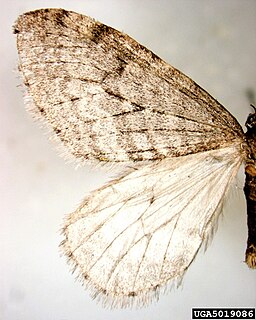
Operophtera bruceata, the Bruce spanworm, hunter's moth, or native winter moth is a moth of the family Geometridae. The species was first described by George Duryea Hulst in 1886. It is found from coast to coast in southern Canada and the northern parts of the United States.

Gonodonta nutrix, the citrus fruitpiercer, is a moth of the family Erebidae. The species was first described by Pieter Cramer in 1780 It is found from in Saint Lucia, Cuba, Jamaica, Florida and from Mexico to Paraguay.

Junonia genoveva, the mangrove buckeye, is a butterfly of the family Nymphalidae. The species was first described by Pieter Cramer in 1780. It is found in South America, and possibly into Central America.

Ennomos subsignaria, the elm spanworm moth, is a moth of the family Geometridae. The species was first described by Jacob Hübner in 1823. It is found in North America from Texas (south) to Alberta (northwest) and east to the Atlantic coast. It is recorded infrequently in Great Britain through accidental importation in asparagus.
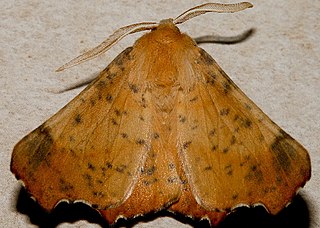
Ennomos magnaria, the maple spanworm moth, notched wing moth, notched-wing geometer or notch-wing moth, is a moth of the family Geometridae. The species was first described by Achille Guenée in 1858. It is found from coast to coast in southern Canada and the northern United States, south in the east to Florida and Louisiana and in the west to California.

Gonodonta sicheas is a moth of the family Erebidae first described by Pieter Cramer in 1777. It is found in Mexico, Guatemala, from Panama to Colombia, Venezuela, Ecuador, Peru, Brazil and on the Antilles. It is also found in the southern United States, including Florida and Texas.

Synchlora herbaria is a moth in the family Geometridae first described by Johan Christian Fabricius in 1794. It is found in Florida, Cuba, Hispaniola, Puerto Rico, the Bahamas, Antigua, Dominica and the Virgin Islands.
Calidota strigosa, the streaked calidota moth, is a moth of the family Erebidae. It was described by Francis Walker in 1855. It is found on the Antilles and from the southern United States to Central America.
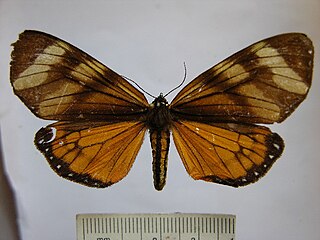
Dysschema eurocilia is a moth of the family Erebidae first described by Pieter Cramer in 1777. It is a common species throughout tropical America, where it has been recorded from the Antilles, Central America and South America.
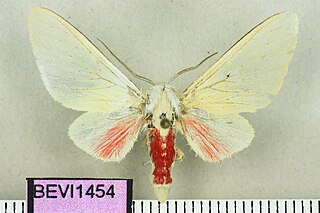
Eupseudosoma involutum, the snowy eupseudosoma, is a moth of the family Erebidae. The species was first described by Sepp in 1855. It is found from the southern United States (Florida) to Argentina, as well as on the Antilles.
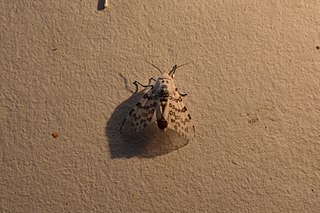
Hypercompe icasia is a moth of the family Erebidae first described by Pieter Cramer in 1777. It is widely distributed in South America and is also found on Martinique, Guadeloupe, Saint Martin, Dominica, St. Kitts, Nevis, St. Thomas and Puerto Rico.

Cydosia nobilitella, the curve-lined cydosia moth or regal cydosia moth, is a moth of the family Noctuidae. The species was first described by Pieter Cramer in 1779. It is found from southern Florida south to Argentina. It is also found on the Antilles.
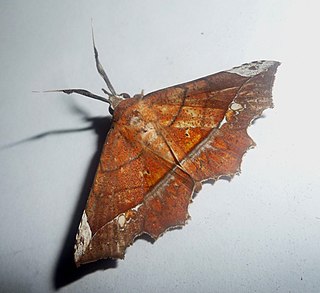
Syllectra erycata is a moth in the family Erebidae first described by Pieter Cramer in 1780. It is found from Florida, Texas and the Antilles to Brazil, Peru, Suriname and Bolivia.

Oxydia vesulia, the spurge spanworm moth, is a species of geometrid moth in the family Geometridae. It is found in the Caribbean Sea, Central America, North America, and South America.


















